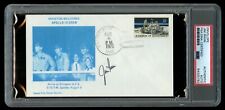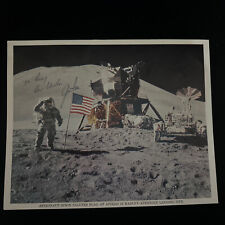|

On eBay Now...
"Apollo 15" James Irwin Hand Signed FDC Dated 1971 For Sale

When you click on links to various merchants on this site and make a purchase, this can result in this site earning a commission. Affiliate programs and affiliations include, but are not limited to, the eBay Partner Network.

"Apollo 15" James Irwin Hand Signed FDC Dated 1971:
$279.99
Up for sale "Apolo15" James Irwin Hand Signed First Day Cover Dated 1971.
ES-2568 James Benson Irwin (March 17, 1930 – August 8, 1991) was an American astronaut, aeronautical engineer, test pilot, and a United States Air Force pilot. He served as Apollo Lunar Module pilot for Apollo 15, the fourth human lunar landing. He was the eighth person to walk on the Moon and the first, and youngest, of those astronauts to die. Irwin was born March 17, 1930, in Pittsburgh, to parents James Irwin and Elsa Mathilda Irwin (née Strebel). Irwin's grandparents emigrated to the U.S. from Altmore Parish at Pomeroy in County Tyrone, Ireland (now Northern Ireland) around 1859. At about the age of 12, he informed his mother about his desire to go to the Moon, letting her know that he might be the first person to do so (he ended up being the eighth). He graduated from East High School in Salt Lake City, Utah in 1947. He received a Bachelor of Science degree in Naval Science from the United States Naval Academy in 1951, and Master of Science degrees in Aeronautical the University of Michigan in 1957. He received initial flight training at Hondo Air Base and follow-on training at Reese Air Force Base, Texas. He graduated from the Air Force Experimental Flight Test Pilot School (Class 60C) in 1961, and the Aerospace Research Pilot School in 1963 (Class IV). Prior to joining NASA, he was chief of the Advanced Requirements Branch at Headquarters Air Defense Command. During his time in the United States Air Force he received the Air Force Distinguished Service Medal and two Air Force Commendation Medals. He also received an Air Force Outstanding Unit Citation while with the 4750th Training Wing. Irwin was also a developmental test pilot for the Lockheed YF-12, the Mach 3 fighter-interceptor variant which preceded the SR-71 Blackbird. His first flight of that aircraft was on the day that one of his five children was born. In 1961, a student pilot that Irwin was training crashed the plane they were flying on a training mission. They both survived, but Irwin suffered compound fractures, amnesia, and nearly lost a leg. John Forrest, a U.S. Air Force orthopedic surgeon, was instrumental in preventing the amputation of Irwin's leg. During his military service, he accumulated more than 7,015 hours flying time, of which 5,300 hours were in jet aircraft. Irwin was one of the 19 astronauts selected by NASA in April 1966. He was chosen as commander, with John S. Bull as Lunar Module Pilot, for LTA-8, an environmental qualification test of the Apollo Lunar Module in a vacuum chamber at the Houston Space Environment Simulation Laboratory. He then served as a member of the astronaut support crew for Apollo 10, the first mission to carry the full Apollo stack to the Moon and the dry run for the first crewed Moon landing. Following that assignment, Irwin served as backup Lunar Module Pilot for the second Moon landing mission, Apollo 12. Between July 26 and August 7, 1971 – as the Apollo 15 Lunar Module Pilot (LMP) – Irwin logged 295 hours and 11 minutes in space. on the Moon's surface amounted to 18 hours and 35 minutes of the mission time (an additional 33 minutes was used for Commander David R. Scott to do a stand-up EVA by opening the LM's docking hatch to survey the surroundings and take photographs). Irwin and David Scott's mission was more science-based than previous missions, which meant that they received intensive geological training to meet the demanding nature of the J-Mission profile. This extra training is credited with allowing them to make one of the most important discoveries of the Apollo era, the Genesis Rock. Apollo 15 landed in the for its mountains and rilles. As a J-Mission, they would spend more time on the Moon than previous missions, to allow for three EVAs. As well, Irwin was the first automobile passenger on the Moon as Scott drove the Lunar Roving Vehicle (LRV) carried along for this mission in the Lunar Module (LM) Falcon's Descent Stage. Scott and Irwin's stay on the Moon was just under three days at 66 hours and 54 minutes. completed between Falcon and the Endeavour CSM, Irwin and Scott were busy moving items like rock samples into the CSM and preparing the Lunar Module for final separation. During this intense period of work the earliest symptoms of a heart condition appeared. Both Scott and Irwin had been working with no sleep for 23 hours, during which they conducted a final moonwalk, performed the ascent from the lunar surface, rendezvoused with Endeavour, and encountered the problems that delayed the Lunar Module jettison maneuver. signs were being monitored back on Earth, and the flight surgeons noticed some irregularities in Irwin's heart rhythms. Irwin's heart had developed bigeminy. Dr. Charles Berry stated to Chris Kraft, deputy director of the Manned Spacecraft Center (MSC) at the time: "It's serious, [i]f he were on Earth. I'd have him in ICU being treated for a heart attack." However, Berry concluded that since Endeavour's cabin atmosphere was 100% oxygen when in space, Irwin was in the best of truth, ... he's in an ICU. He's getting one hundred percent oxygen, he's being continuously monitored, and best of all, he's in zero g. Whatever strain his heart is under, well, we can't do better than zero g." During the post-trans-Earth injection (TEI) phase of the mission there wasn't much more for Irwin to do other than provide help with Al Worden's EVA to retrieve film magazines from the CSM's SIM bay, by donning a pressure suit and monitoring him. He was able to rest and apparently recover during the rest of the mission. The flight surgeons continued to monitor his EKG until splashdown, but his heart rhythm was normal. This incident was not discussed during the mission debriefing sessions, and the condition did not appear when he returned to Earth.


James Jim Irwin signed autograph Envelope Moonwalker Apollo 15 Astronaut PSA $300.00

Signed Astronaut Irwin Salutes Apollo 15 Hadley-Apennine Landing Site $350 OBO $350.00

NASA Apollo 15 Astronaut JAMES IRWIN'S 8"x10" Photo AUTOGRAPHED Excellent $120.00

Vintage Apollo 15 Lunar Rover Fiberglas Acrylic Display Piece Scott Worden Irwin $299.99

Vintage 1972 NASA Apollo 15 Moon Mission Boxed Set of 25 Movie Newsreel Slides $14.99

7 NASA Space Patches LOT Teacher in Space, Apollo 15, STS-40, 41D, 51J, 71 & 80 $8.99

James Jim Irwin Signed Landing Site NASA Lithograph Apollo 15 $134.99

AL WORDEN SIGNED AUTOGRAPHED 8x10 PHOTO APOLLO 15 ASTRONAUT NASA BECKETT BAS $265.00
|